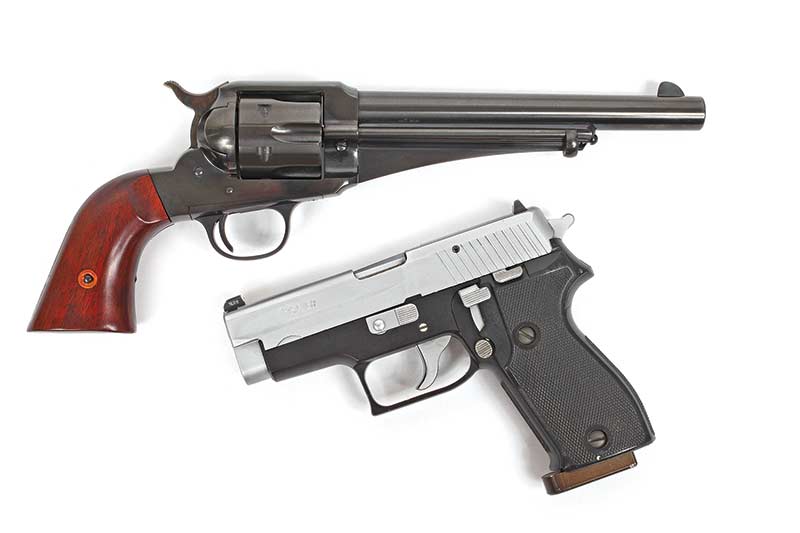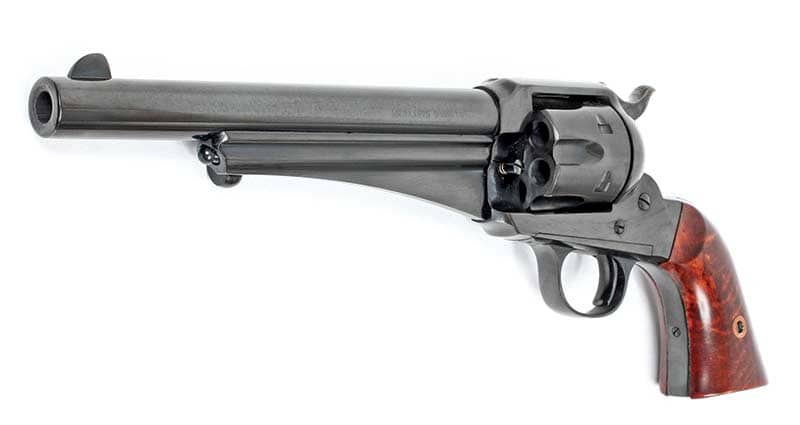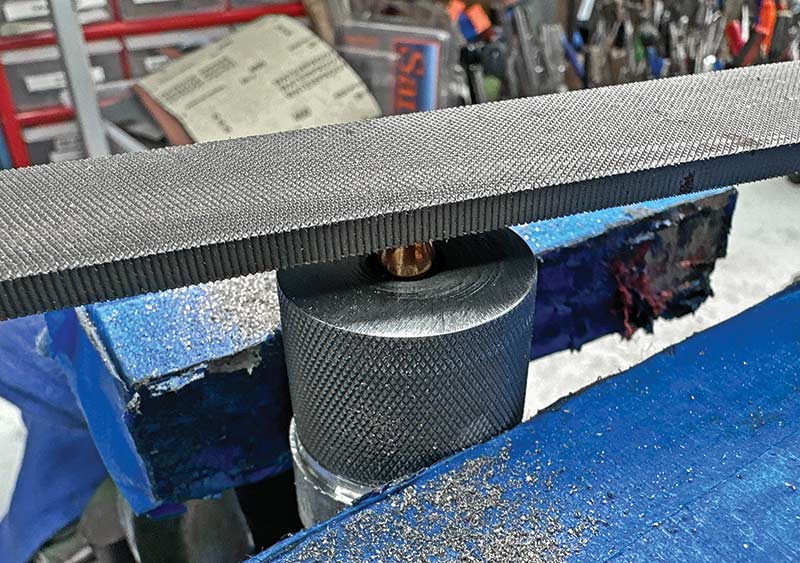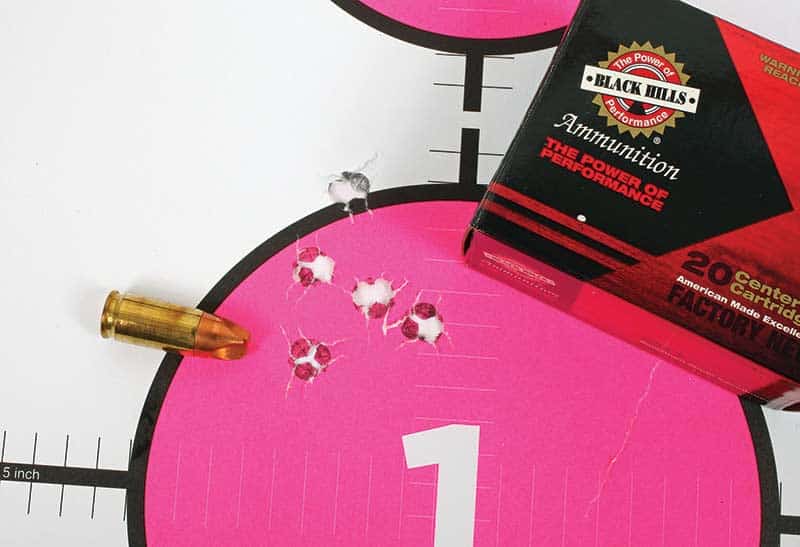A Surprising 9mm Option
Yeah, I know … a classic single action should only be .45 Colt or maybe 44-40. If you’re really nostalgic, maybe even 32-20 or, dare I say it — .44 Special? But what if there was another idea and it didn’t cause the shooting gods to tremble, the Internet warriors to become outraged (“How dare he say that!”) or have SASS banish you forever from wearing a cowboy hat? Do I venture where few have gone before? You bet.
I got an always-fun email blast from Taylor’s & Co. a while ago, and right at the top was an attractive 7″ 1875 Remington single action. I’ve always thought they were compelling, and so did adventurers in the West. Based on the black powder 1858 design, the 1875 kept the same solid frame top and the underlug but became a cartridge revolver. They were tough, handled great and chased the Colt models of the day for popularity. While I was gazing, wondering if I should click the “buy” button, I read it was chambered in 9mm. What? Huh?
At first, I thought, “Well, that’s silly; why do that?” Then I pondered a bit. So, if a 9mm is fine for protection, fine for targeting, fine for matches, fine for training, fine even for small game and fine for reloading — then why not chamber it in a single action? The way has been paved in the past by “Convertible” single actions. Ruger has led the pack with their .45 Colt/.45 ACP models and their .357/9mm convertibles. They sold steadily, but you didn’t hear much about people shooting the auto chamberings.
The more I thought about it, the more I wanted to experiment. Once the gun arrived, I admit I was very surprised by the high build quality from Uberti. Today’s guns are every bit as good as anything Colt might have done (or does?), and the action on my gun is smooth and sure, having the appropriate amount of “clickiness” expected for the breed. You need to half-cock the hammer to load and eject, and the trigger pull is a very surprising — and consistent — 2.5 lbs.
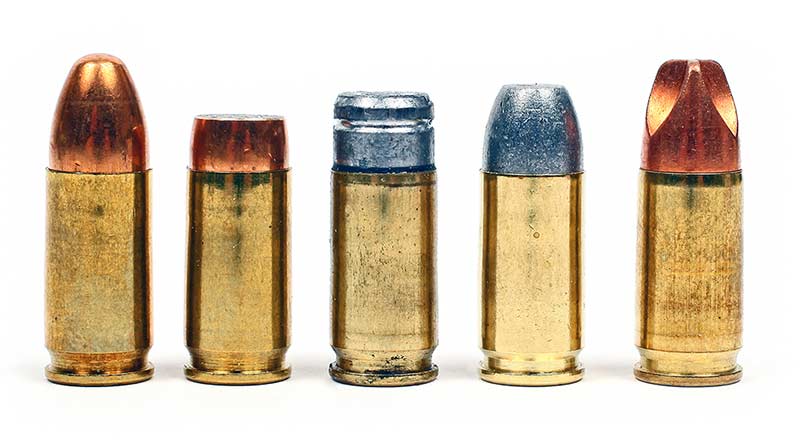
The 9mm chambering means you can shoot any bullet you like.
Left to right: 115 FMJ Winch., Roy’s custom “filed down” 115,
turning it into a 100-grain bullet, a 148-grain .38 wadcutter
sized to .355, Buffalo Bore’s 147-grain hard cast lead FP and
the very effective Black Hills HoneyBadger load. All ran just fine.
Ideas
Even today, 9mm ball ammo is among the cheapest factory ammo you can buy. If you have a stash from long ago, chances are good you’re into it for 15 cents or so per round. In today’s world, you pretty much can’t reload it for that. And one of the best things about a semi-auto chambered single action is you don’t chase the empties!
After some initial shooting with Winchester 115-grain FMJ ammo, I found the 1875 to be amazingly accurate, and the crisp trigger and muzzle-heavy feel added to the delight of shooting it. Then I got to thinking.
I shoot a lot of 148-grain target wadcutters in .38 Special. So, I tried using standard .38 wadcutter bullets in reloaded 9mm brass as a test, but at 0.357″, they were just too big, and most would bulge the case and not chamber. A Lee sizer (0.355″) meant I could re-size the .38 bullets and load them into 9mm cases. About $35 later, I had the die and a nifty way to use my RCBS single stage to resize the wadcutters. A quick look gave me a Unique load and some initial loads assembled easily. This was fun, I thought.
As I suspected, the lead wadcutter loads shot like lasers. What a great defensive load, small game and target load — and they’re cheap to shoot. Suddenly, CCI 9mm shot cartridges made better sense, too. If it’s 9mm, it’ll shoot in this gun. I also remembered a trick from decades ago on how to make a “speed loader,” so I dug up a beater 9mm magazine, spread the feed lips a bit, and presto, I had a 9mm speed loader for my gun. Open the gate, thumb a round in and repeat as needed. Old guys know things, ha!
I also made a simple die from a piece of scrap steel to hold a loaded 115-grain FMJ round. I then simply filed a flat on the bullet. It turned them from a 115 RN into serious-looking jacketed flat-points of about 100 grains. Velocity went from 1,100 fps or so to the 1,350 fps range with the lighter bullets. How fun is this?
Targeting
I targeted a few loads from a rest at 20 yards. All the groups were essentially in the same size range, roughly 1.5″, not counting a flyer or two induced by the goof behind the trigger. Even with the very rudimentary original style sights, this gun is a real shooter. The longish 7″ barrel and underlug really stabilized things and that great trigger helps too. I can see myself installing decent fixed front and rear sights in dovetails to take full advantage of this accuracy.
I did some chronographing using my old duty SIG P225 to get a shorter barrel result along with the Taylor’s gun. The lead wadcutter load wouldn’t chamber in the SIG but ran about 900 fps in the sixgun. The factory Winchester 115 FMJ ran 1,150 in the Remington, then 1,080 in the SIG. Black Hills HoneyBadger averaged 915 in the Remington and 940 in the SIG (the only load going faster in the auto). My filed flat-nose bullets clocked 1,340 in the Remington and 1,160 in the SIG (and fed, much to my surprise). An interesting Buffalo Bore 147-grain hard cast flat nose went 1,155 in the Remington and 1,015 in the SIG.
The options are limitless here. Bullet designs are not a limitation, so if you can think it, you can shoot it. And for you naysayers, I checked, and a 9mm is SASS-legal as long as you meet their loading criteria with lead bullets and velocities for cowboy action shooting.
It’s always fun to wander off in a new direction, and I plan on wandering pretty far with this natty gun/cartridge combo.
For more info: TaylorsFirearms.com, TacticalTargetSystems.com

